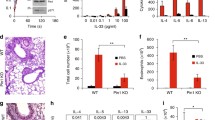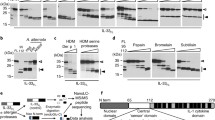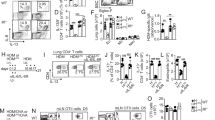Abstract
We previously demonstrated in the human promyelocytic cell line THP-1 that all allergens tested, with the exception of the prohapten isoeugenol, induced a dose-related release of interleukin-8 (IL-8). In the present study, we investigated whether this abnormal behavior was regulated by the AU-rich element–binding proteins HuR and tristetraprolin (TTP) or by the downstream molecule suppressor of cytokine signaling (SOCS)-3. The contact allergens isoeugenol, diethylmaleate (DEM), and 2,4-dinitrochlorobenzene (DNCB), and the irritant salicylic acid were used as reference compounds. Chemicals were used at concentrations that induced a 20% decrease in cell viability as assessed by propidium iodide staining, namely 100 μg/ml (0.61 mM) for isoeugenol, 100 μg/ml (0.58 mM) for DEM, 3 μg/ml (14.8 μM) for DNCB, and 250 μg/ml (1.81 mM) for salicylic acid. Time course experiments of IL-8 mRNA expression and assessment of IL-8 mRNA half-life, indicated a decreased IL-8 mRNA stability in isoeugenol-treated cells. We could demonstrate that a combination and regulation of HuR and TTP following exposure to contact allergens resulted in a different modulation of IL-8 mRNA half-life and release. The increased expression of TTP in THP-1 cells treated with isoeugenol results in destabilization of the IL-8 mRNA, which can account for the lack of IL-8 release. In contrast, the strong allergen DNCB failing to up-regulate TTP, while inducing HuR, resulted in longer IL-8 mRNA half-life and protein release. SOCS-3 was induced only in isoeugenol-treated cells; however, its modulation did not rescue the lack of IL-8 release, indicating that it is unlikely to be involved in the lack of IL-8 production. Finally, the destabilization effect of isoeugenol on IL-8 mRNA expression together with SOCS-3 expression resulted in an anti-inflammatory effect, as demonstrated by the ability of isoeugenol to modulate LPS or ionomycin-induced cytokine release.




Similar content being viewed by others
References
Anant S, Houchen CW (2009) HuR and TTP: two RNA binding proteins that deliver message from the 3′ end. Gastroenterology 136:1495–1498
Anderson P, Phillips K, Stoecklin G, Kedersha N (2004) Post-transcriptional regulation of proinflammatory proteins. J Leukoc Biol 76:42–47
Azam P, Peiffer JL, Chamousset D, Tissier MH, Bonnet PA, Vian L, Fabre I, Ourlin JC (2006) The cytokine-dependent MUTZ-3 cell line as an in vitro model for the screening of contact sensitizers. Toxicol Appl Pharmacol 212:14–23
Balakathiresan NS, Bhattacharyya S, Gutti U, Long RP, Jozwik C, Huang W, Srivastava M, Pollard HB, Biswas R (2009) Tristetraprolin regulates IL-8 mRNA stability in cystic fibrosis lung epithelial cells. Am J Physiol Lung Cell Mol Physiol 296:L1012–L1018
Barreau C, Paillard L, Osborne HB (2006) AU-rich elements and associated factors: are there unifying principles? Nucleic Acids Res 33:7138–7150
Blackshear PJ (2002) Tristetraprolin and other CCCH tandem zinc-finger proteins in the regulation of mRNA turnover. Biochem Soc Trans 30:945–952
Brook M, Tchen CR, Santalucia T, McIlrath J, Arthur JS, Saklatvala J, Clark AR (2006) Posttranslational regulation of tristetraprolin subcellular localization and protein stability by p38 mitogen-activated protein kinase and extracellular signal-regulated kinase pathways. Mol Cell Biol 26:2408–2418
Casati S, Aeby P, Basketter DA, Cavani A, Gennari A, Gerberick GF, Griem P, Hartung T, Kimber I, Lepoittevin JP, Meade BJ, Pallardy M, Rougier N, Rousset F, Rubinstenn G, Sallusto F, Verheyen GR, Zuang V (2005) The report and recommendations of ECVAM workshop 51. Dendritic cells as a tool for the predictive identification of skin sensitisation hazard. Altern Lab Anim 33:47–62
Choi CY, Park KR, Lee JH, Jeon YJ, Liu KH, Oh S, Kim DE, Yea SS (2007) Isoeugenol suppression of inducible nitric oxide synthase expression is mediated by down-regulation of NF-kappaB, ERK1/2, and p38 kinase. Eur J Pharmacol 576:151–159
Corsini E, Kimber I (2007) Factors governing susceptibility to chemical allergy. Toxicol Lett 168:255–259
Corsini E, Roggen EL (2009) Immunotoxicology: opportunities for non-animal test development. Altern Lab Anim 37:387–397
Dean JL, Sully G, Clark AR, Saklatvala J (2004) The involvement of AU-rich element-binding proteins in p38 mitogen-activated protein kinase pathway-mediated mRNA stabilisation. Cell Signal 16:1113–1121
Dixon DA, Tolley ND, King PH, Nabors LB, McIntyre TM, Zimmerman GA, Prescott SM (2001) Altered expression of the mRNA stability factor HuR promotes cyclooxygenase-2 expression in colon cancer cells. J Clin Invest 108:1657–1665
dos Santos GG, Reinders J, Ouwehand K, Rustemeyer T, Scheper RJ, Gibbs S (2009) Progress on the development of human in vitro dendritic cell based assays for assessment of the sensitizing potential of a compound. Toxicol Appl Pharmacol 236:372–382
DuBois RN, McLane MW, Ryder K, Lau LF, Nathans D (1990) A growth factor-inducible nuclear protein with a novel cysteine/histidine repetitive sequence. J Biol Chem 265:19185–19191
Fukushima A, Kajiya H, Izumi T, Shigeyama C, Okabe K, Anan H (2010) Pro-inflammatory cytokines induce suppressor of cytokine signaling-3 in human periodontal ligament cells. J Endod 36:1004–1008
Galbiati V, Mitjans M, Corsini E (2010) Present and future of in vitro immunotoxicology in drug development. J Immunotoxicol 7:255–267
Hoffmann E, Dittrich-Breiholz O, Holtmann H, Kracht M (2002) Multiple control of interleukin-8 gene expression. J Leukoc Biol 72:847–855
Kimber I, Mitchell JA, Griffin AC (1986) Development of a murine local lymph node assay for the determination of sensitizing potential. Food Chem Toxicol 24:585–586
Lankveld DP, Van Loveren H, Baken KA, Vandebriel RJ (2010) In vitro testing for direct immunotoxicity: state of the art. Methods Mol Biol 598:401–423
Li W, Tsubouchi R, Qiao S, Haneda M, Murakami K, Yoshino M (2006) Inhibitory action of eugenol compounds on the production of nitric oxide in RAW264.7 macrophages. Biomed Res 27:69–74
Ma WJ, Cheng S, Campbell C, Wright A, Furneaux H (1996) Cloning and characterization of HuR, a ubiquitously expressed Elav-like protein. J Biol Chem 271:8144–8151
Mitjans M, Viviani B, Lucchi L, Galli CL, Marinovich M, Corsini E (2008) Role of p38 MAPK in the selective release of IL-8 induced by chemical allergen in naive THP-1 cells. Toxicol In Vitro 22:386–395
Mitjans M, Galbiati V, Lucchi L, Viviani B, Marinovich M, Galli CL, Corsini E (2010) Use of IL-8 release and p38 MAPK activation in THP-1 cells to identify allergens and to assess their potency in vitro. Toxicol In Vitro 24:1803–1809
Murray AJ (2008) Pharmacological PKA inhibition: all may not be what it seems. Sci Signal 1:re 4
Muselet-Charlier C, Roque T, Boncoeur E, Chadelat K, Clement A, Jacquot J, Tabary O (2007) Enhanced IL-1beta-induced IL-8 production in cystic fibrosis lung epithelial cells is dependent of both mitogen-activated protein kinases and NF-kappaB signaling. Biochem Biophys Res Commun 357:402–407
Myer VE, Fan XC, Steitz JA (1997) Identification of HuR as a protein implicated in AUUUA-mediated mRNA decay. EMBO J 16:2130–2139
Nabors LB, Furneaux HM, King PH (1998) HuR, a novel target of anti-Hu antibodies, is expressed in non-neural tissues. J Neuroimmunol 92:152–159
Neves BM, Gonçalo M, Figueiredo A, Duarte CB, Lopes MC, Cruz MT (2011) Signal transduction profile of chemical sensitisers in dendritic cells: an endpoint to be included in a cell-based in vitro alternative approach to hazard identification? Toxicol Appl Pharmacol 250:87–95
Newbury SF (2006) Control of mRNA stability in eukaryotes. Biochem Soc Trans 34:30–34
Palanisamy V, Park NJ, Wang J, Wong DT (2008) AUF1 and HuR proteins stabilize interleukin-8 mRNA in human saliva. J Dent Res 87:772–776
Rajakumar DV, Rao MN (1993) Dehydrozingerone and isoeugenol as inhibitors of lipid peroxidation and as free radical scavengers. Biochem Pharmacol 46:2067–2072
Ronkina N, Kotlyarov A, Dittrich-Breiholz O, Kracht M, Hitti E, Milarski K, Askew R, Marusic S, Lin LL, Gaestel M, Telliez JB (2007) The mitogen-activated protein kinase (MAPK)-activated protein kinases MK2 and MK3 cooperate in stimulation of tumor necrosis factor biosynthesis and stabilization of p38 MAPK. Mol Cell Biol 27:170–181
Ronkina N, Menon MB, Schwermann J, Tiedje C, Hitti E, Kotlyarov A, Gaestel M (2010) MAPKAP kinases MK2 and MK3 in inflammation: complex regulation of TNF biosynthesis via expression and phosphorylation of tristetraprolin. Biochem Pharmacol 80:1915–1920
Shim J, Lim H, Yates JR III, Karin M (2002) Nuclear export of NF90 is required for interleukin-2 mRNA stabilization. Mol Cell 10:1331–1344
Taylor GA, Carballo E, Lee DM, Lai WS, Thompson MJ, Patel DD, Schenkman DI, Gilkeson GS, Broxmeyer HE, Haynes BF, Blackshear PJ (1996) A pathogenetic role for TNF alpha in the syndrome of cachexia, arthritis, and autoimmunity resulting from tristetraprolin (TTP) deficiency. Immunity 4:445–454
Vandebriel RJ, van Loveren H (2010) Non-animal sensitization testing: state-of-the-art. Crit Rev Toxicol 40:389–404
Worthington MT, Pelo JW, Sachedina MA, Applegate JL, Arseneau KO, Pizarro TT (2002) RNA binding properties of the AU-rich element-binding recombinant Nup475/TIS11/tristetraprolin protein. J Biol Chem 277:48558–48564
Yoshimura A, Naka T, Kubo M (2007) SOCS proteins, cytokine signalling and immune regulation. Nat Rev Immunol 7:454–465
Acknowledgments
We would like to thank Professor Henk Van Loveren for his review and helpful suggestions. This research was supported by the EU grant SENS-IT-IV #018681 and by the 2008 Eurotox, HSUS, P&G Animal Welfare and Alternatives Award.
Conflict of interest
Authors declare not having any financial or personal interest, nor having an association with any individuals or organizations that could have influenced inappropriately the submitted work.
Author information
Authors and Affiliations
Corresponding author
Rights and permissions
About this article
Cite this article
Galbiati, V., Carne, A., Mitjans, M. et al. Isoeugenol destabilizes IL-8 mRNA expression in THP-1 cells through induction of the negative regulator of mRNA stability tristetraprolin. Arch Toxicol 86, 239–248 (2012). https://doi.org/10.1007/s00204-011-0758-2
Received:
Accepted:
Published:
Issue Date:
DOI: https://doi.org/10.1007/s00204-011-0758-2




